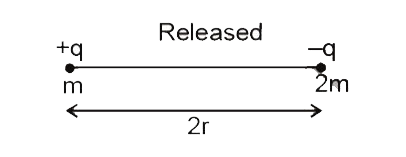The gravitational force between two objects is proportional to (and not as ) where is separation between them, then a particle in circular orbit under such a force would have its orbital speed proportional to
The correct Answer is:B
To solve the problem, we need to analyze the relationship between gravitational force and orbital speed when the gravitational force is proportional to 1R instead of the usual 1R2.
1. Understanding the Gravitational Force:
The problem states that the gravitational force F between two objects is proportional to 1R, where R is the separation between the two objects. This can be expressed as:
F=k⋅M1M2R
where k is a constant of proportionality, and M1 and M2 are the masses of the two objects.
2. Centripetal Force Requirement:
For an object of mass M2 moving in a circular orbit of radius R around mass M1, the centripetal force required to keep it in orbit is given by:
Fcentripetal=M2v2R
where v is the orbital speed of the object.
3. Setting the Forces Equal:
In a stable circular orbit, the gravitational force must equal the centripetal force:
k⋅M1M2R=M2v2R
4. Canceling M2 and R:
Since M2 appears on both sides of the equation, we can cancel it out (assuming M2≠0):
k⋅M1R=v2R
Now, we can multiply both sides by R:
k⋅M1=v2
5. Finding the Relationship of v:
From the equation v2=k⋅M1, we can express v as:
v=√k⋅M1
Here, k and M1 are constants, meaning that v does not depend on R at all.
6. Conclusion:
Since v is independent of R, we can say that the orbital speed v is proportional to R0 (which is 1). Therefore, the correct answer is that the orbital speed v is proportional to R0.
Final Answer:
The orbital speed v is proportional to R0.
The problem states that the gravitational force F between two objects is proportional to 1R, where R is the separation between the two objects. This can be expressed as:
F=k⋅M1M2R
where k is a constant of proportionality, and M1 and M2 are the masses of the two objects.
For an object of mass M2 moving in a circular orbit of radius R around mass M1, the centripetal force required to keep it in orbit is given by:
Fcentripetal=M2v2R
where v is the orbital speed of the object.
In a stable circular orbit, the gravitational force must equal the centripetal force:
k⋅M1M2R=M2v2R
Since M2 appears on both sides of the equation, we can cancel it out (assuming M2≠0):
k⋅M1R=v2R
Now, we can multiply both sides by R:
k⋅M1=v2
From the equation v2=k⋅M1, we can express v as:
v=√k⋅M1
Here, k and M1 are constants, meaning that v does not depend on R at all.
Since v is independent of R, we can say that the orbital speed v is proportional to R0 (which is 1). Therefore, the correct answer is that the orbital speed v is proportional to R0.
The orbital speed v is proportional to R0.
Topper's Solved these Questions
- GRAVITATIONBOOK - CENGAGE PHYSICSCHAPTER - GRAVITATIONEXERCISE - Multiple Correct
24 Videos
- GRAVITATIONBOOK - CENGAGE PHYSICSCHAPTER - GRAVITATIONEXERCISE - Assertion- Reasoning
13 Videos
- GRAVITATIONBOOK - CENGAGE PHYSICSCHAPTER - GRAVITATIONEXERCISE - Subjective
15 Videos
- FLUID MECHANICSBOOK - CENGAGE PHYSICSCHAPTER - FLUID MECHANICSEXERCISE - INTEGER_TYPE
1 Videos
- KINEMATICS-1BOOK - CENGAGE PHYSICSCHAPTER - KINEMATICS-1EXERCISE - Integer
9 Videos
Similar Questions
Knowledge Check
If the gravitational force between two objects were proportional to 1/R (and not as 1/R2), where R is the distance between them, then a particle in a circular path (under such a force) would have its orbital speed v, proportional to
Aremains unchangedBR0 (independent of R)C1/R2D1/RIf the gravitational force were potential to 1r, then a particle in a circular orbit under such a force would have its original speed:
AIndepdent of rB∝1rC∝1r2D∝r2Suppose that the gravitational force between two bodies separated by a distance R becomes inversely proportional to R (and not as 1R2 as given by Newton's law of gravitation). Then the speed of a particle moving in a circular orbit of radius R under such a force would be proportional to
A1R2BR0CRD1R
Find out speed of particles when separation between them is r.

View SolutionThe gravitational force between two particles separated by a distance r varies as ……………
View SolutionThe gravitational force between two particles separated by a distance r varies as ……………
View SolutionThe gravitational force between two object is F. It masses of both object are halved without changing distance between them, then the gravitation force would become
View SolutionThe force between two electrons separated by a distance r is proportional to
View Solution
